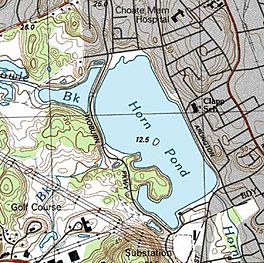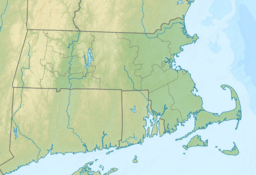Horn Pond (Massachusetts) facts for kids
Quick facts for kids Horn Pond |
|
|---|---|

USGS Topographical Map showing Horn Pond.
|
|
| Location | Woburn, Massachusetts |
| Coordinates | 42°28′11″N 71°09′23.1″W / 42.46972°N 71.156417°W |
| Type | Natural great pond |
| Primary inflows | Fowle Brook & Cummings Brook |
| Primary outflows | Horn Pond Brook to Aberjona River |
| Basin countries | United States |
| Surface area | 102 acres (0.2 sq mi) |
| Average depth | 10 ft (3.0 m) Average transparency: 6 ft (1.8 m) |
| Max. depth | 40 ft (12.2 m) |
| Surface elevation | 139 ft (42.4 m) |
| Settlements | Woburn, Massachusetts |
Horn Pond is a beautiful natural pond located in Woburn, Massachusetts, in the United States. It's about 102 acres big, which is like 77 football fields! This pond is an important part of the local water system. Water flows into Horn Pond from smaller streams called brooks. Then, the water flows out through Horn Pond Brook, connecting to the Aberjona River and eventually reaching the Mystic River and the Atlantic Ocean. Long ago, a special waterway called the Middlesex Canal even passed through Horn Pond.
Contents
Discover Horn Pond
Horn Pond is a large natural pond in Woburn, Massachusetts. It covers about 102 acres, making it a significant body of water in the area. The pond is fed by two main streams, Fowle Brook and Cummings Brook.
Water from Horn Pond flows out through Horn Pond Brook. This brook then joins the Aberjona River. The Aberjona River eventually leads to the Mystic Lakes and the Mystic River. Finally, the water from Horn Pond reaches the Atlantic Ocean.
Horn Pond's Depth and Clarity
The average depth of Horn Pond is about 10 feet. However, some parts of the pond are much deeper. The deepest spot in Horn Pond is around 40 feet!
The water in Horn Pond is also quite clear. On average, you can see about 6 feet down into the water. This clarity helps sunlight reach plants growing underwater.
Animals Living in Horn Pond
Horn Pond is home to many different kinds of fish. Scientists studied the pond in 1982 to see what species lived there. They found a wide variety of fish, showing that the pond is a healthy habitat.
Fish Species You Might Find
The most common fish found in Horn Pond is the yellow perch. These fish are popular with anglers and are known for their yellow sides and dark stripes.
Other fish species living in the pond include:
- Largemouth bass: A popular sport fish known for its big mouth.
- Pumpkinseed: A small, colorful sunfish.
- Bluegill: Another common sunfish, often found in ponds.
- Killifish: Small, hardy fish that live near the surface.
- Chain pickerel: A long, slender fish with a chain-like pattern.
- Golden shiner: A shiny, silvery baitfish.
- Carp: A large freshwater fish.
- White sucker: A bottom-feeding fish.
- Brook trout: A beautiful trout species.
- Yellow bullhead: A type of catfish with a yellow belly.
- Brown bullhead: Another type of catfish, usually darker.
- Black crappie: A popular panfish.
Stocking Trout in the Pond
Sometimes, new fish are added to Horn Pond to help keep the fish population healthy. This is called "stocking." In the past, trout have been stocked in the pond. These usually include rainbow trout, but sometimes brown trout and brook trout are added too. More fish, especially trout, are often stocked in the fall.
Exploring Horn Pond's History
Horn Pond has a fascinating history, especially its connection to an old waterway. From 1802 to 1860, a very important canal passed right through Horn Pond.
The Middlesex Canal
The waterway that crossed Horn Pond was called the Middlesex Canal. This canal was a huge engineering project for its time. It was built to connect the Merrimack River in Lowell, Massachusetts, to the Charles River in Boston.
The canal allowed boats to transport goods like timber, granite, and other products from inland areas to the busy port of Boston. Horn Pond was a natural part of this canal system. Boats would travel across the pond as they made their way along the canal. The Middlesex Canal was used for about 58 years before railroads became the main way to transport goods.



